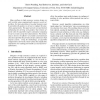Free Online Productivity Tools
i2Speak
i2Symbol
i2OCR
iTex2Img
iWeb2Print
iWeb2Shot
i2Type
iPdf2Split
iPdf2Merge
i2Bopomofo
i2Arabic
i2Style
i2Image
i2PDF
iLatex2Rtf
Sci2ools
109
Voted
HASE
2007
IEEE
2007
IEEE
An Efficient Experimental Methodology for Configuring Search-Based Design Algorithms
Many problems in high assurance systems design are only tractable using computationally expensive search algorithms. For these algorithms to be useful, designers must be provided with guidance as to how to configure the algorithms appropriately. This paper presents an experimental methodology for deriving such guidance that remains efficient when the algorithm requires substantial computing resources or takes a long time to find solutions. The methodology is shown to be effective on a highly-constrained task allocation algorithm that provides design solutions for high integrity systems. Using the methodology, an algorithm configuration is derived in a matter of days that significantly outperforms one resulting from months of `trial-and-error' optimisation.
Related Content
| Added | 16 Aug 2010 |
| Updated | 16 Aug 2010 |
| Type | Conference |
| Year | 2007 |
| Where | HASE |
| Authors | Simon M. Poulding, Paul Emberson, Iain Bate, John A. Clark |
Comments (0)

